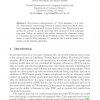IVA
2005
Springer
14 years 5 months ago
2005
Springer
We present an interactive installation with life-size virtual agents that inform, entertain, encourage, and assist visitors during the process of building a car. It will be install...
IVA
2005
Springer
14 years 5 months ago
2005
Springer
Abstract. Non-verbal communication, or “body language”, is a critical component in constructing believable virtual characters. Most often, body language is implemented by a set...
IVA
2005
Springer
14 years 5 months ago
2005
Springer
Causality is a central issue in many AI applications. Social causality, in contrast to physical causality, seeks to attribute cause and responsibility to social events, and account...
IVA
2005
Springer
14 years 5 months ago
2005
Springer
Psychology and cognitive neuroscience researches are increasingly showing how emotion plays a crucial role in cognitive processes. Gradually, this knowledge is being used in Artifi...
IVA
2005
Springer
14 years 5 months ago
2005
Springer
Abstract. This paper details a framework for explicit deliberative control of socially and physically situated agents in virtual, real and mixed reality environments. The objective...
IVA
2005
Springer
14 years 5 months ago
2005
Springer
Abstract. In contrast to the variety of listening behaviors produced in humanto-human interaction, most virtual agents sit or stand passively when a user speaks. This is a reflecti...
IVA
2005
Springer
14 years 5 months ago
2005
Springer
INTERFACE is an integrated software implemented in Matlab© and created to speed-up the procedure for building an emotive/expressive talking head. Various processing tools, working...
IVA
2005
Springer
14 years 5 months ago
2005
Springer
In this paper, we propose a new integration approach to simulate an Autonomous Virtual Agent's cognitive learning of a task for interactive Virtual Environment applications. O...
IVA
2005
Springer
14 years 5 months ago
2005
Springer
This paper describes an application of the conversational agent Max in a real-world setting. The agent is employed as guide in a public computer museum, where he engages with visit...
IVA
2005
Springer
14 years 5 months ago
2005
Springer
An important characteristic of a virtual human is the ability to direct its perceptual attention to entities and areas in a virtual environment in a manner that appears believable ...






